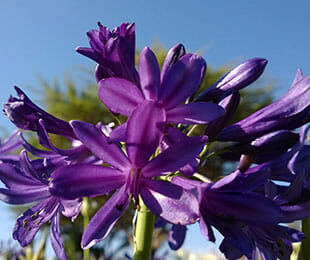Agapanthus Varieties: Selecting the very best for Your Landscape
Wiki Article
Understanding the Art of Agapanthus Treatment: Essential Actions for Healthy Growth and Vivid Flowers
In the world of gardening, the growing of agapanthus stands as a satisfying venture for those that seek to nurture these sophisticated blooming plants. With their striking blooms and stylish vegetation, agapanthus has recorded the focus of garden enthusiasts worldwide. Nonetheless, attaining ideal development and lively blossoms calls for a nuanced method that includes different necessary actions. From choosing the best selection to grasping pruning strategies, the trip in the direction of growing flourishing agapanthus plants is complex and holds the crucial to opening the complete capacity of these agricultural gems.
Selecting the Right Agapanthus Selection

When selecting the right Agapanthus variety for your garden, take into consideration factors such as climate suitability, flower shade, and development practice. Agapanthus, commonly called Lily of the Nile or African lily, is available in a selection of shades varying from shades of blue and purple to white. Select a bloom color that enhances your existing garden combination to develop an unified landscape. Furthermore, consider the environment in your region to make sure the Agapanthus variety you choose can flourish in your certain conditions. Some varieties are much more tolerant of chilly temperature levels, while others like warmer climates. Comprehending the growth behavior of various Agapanthus ranges is important for appropriate placement within your garden. Some varieties have a clumping development routine, perfect for borders or containers, while others have an even more dispersing nature, ideal for ground cover or mass plantings. By carefully assessing these aspects, you can select the best Agapanthus range to enhance the beauty of your garden.
Ideal Planting Problems
Taking into consideration the optimal ecological requirements is crucial for successful Agapanthus growing. Agapanthus thrives in well-draining dirt with a slightly acidic to neutral pH level. When planting, choose a place that receives complete sunlight to partial color. In hotter climates, supplying some mid-day color can protect against scorching of the leaves. Agapanthus plants are delicate to chilly temperature levels and must be protected from frost during winter season.To make certain healthy development and vibrant flowers, plant Agapanthus light bulbs at a deepness of regarding 2-4 inches and room them 8-12 inches apart. Adding natural matter, such as garden compost, to the dirt can boost drainage and fertility, promoting durable root advancement. Mulching around the base of the plants helps retain moisture and suppresses weed development. Routine watering is crucial, especially throughout the growing period, to maintain the dirt continually damp but not saturated.
Watering and Feeding Tips
Keeping correct dampness degrees and providing important nutrients are essential aspects in the care program for Agapanthus plants. When it comes to sprinkling Agapanthus, it is important to strike a balance. If overwatered, these plants like continually damp soil but are susceptible to resource root rot. During the growing period, water deeply as soon as a week, ensuring the dirt is well-draining to stop waterlogging. In hotter climates or throughout periods of drought, even more constant watering might be needed to keep the dirt equally wet. Nevertheless, decrease watering in the winter to stop waterlogged conditions.Feeding Agapanthus is important for promoting healthy development and prolific blossoms. Apply a balanced plant food, such as a 10-10-10 formula, in the very early spring as brand-new growth emerges. Repeat this application every 6-8 weeks throughout the growing period. Stay clear of extreme fertilizing, as it can lead to lush foliage at the expense of blossoms. Always follow the maker's guidelines for correct dilution and application methods. By adhering to these watering and fertilizing tips, you can guarantee your Agapanthus plants prosper and produce lively, long-lasting blooms.
Trimming Techniques for Agapanthus
Trimming Agapanthus plants at the proper times and with correct techniques is critical for maintaining their health and wellness and promoting ideal development and blooming. The suitable time to trim Agapanthus is in late wintertime or very early spring before new growth emerges.Deadheading spent blossoms can likewise redirect the plant's power right into producing more flowers rather than establishing seeds. If you desire to accumulate seeds for proliferation, leave some flowers to mature and dry on the plant.
Keep in mind to utilize clean, sharp tools to make precise cuts and reduce the risk of introducing conditions. Agapanthus. Routine pruning will aid maintain your Agapanthus looking healthy and balanced and cool while making certain a plentiful screen of gorgeous blossoms
Handling Typical Bugs and Conditions
After ensuring appropriate pruning techniques for Agapanthus, it is essential to resolve typical insects and illness that can impact the wellness and vitality of these plants. One common bug that affects Agapanthus is the Agapanthus gall midge.Furthermore, Agapanthus plants browse this site can suffer from root rot if they are grown in badly draining pipes soil. By being watchful and taking punctual action against illness and insects, you can assist your Agapanthus plants prosper and generate lively flowers. Agapanthus.

Conclusion
To conclude, grasping the art of agapanthus treatment includes selecting the ideal variety, offering ideal planting conditions, correct watering and feeding, appropriate pruning techniques, and resolving typical insects and conditions. By adhering to these vital actions, you can guarantee healthy growth and vibrant blooms for your agapanthus plants. Remember to consistently keep an eye on and keep your plants to advertise their overall well-being and durability.To make certain healthy and balanced growth and vibrant blossoms, plant Agapanthus light bulbs at a deepness of about 2-4 inches official website and room them 8-12 inches apart. By complying with these watering and feeding tips, you can ensure your Agapanthus plants grow and generate vivid, durable blooms.
One usual pest that affects Agapanthus is the Agapanthus gall midge. Additionally, Agapanthus plants can endure from root rot if they are grown in badly draining pipes dirt. By adhering to these essential steps, you can make certain healthy development and vivid flowers for your agapanthus plants.
Report this wiki page